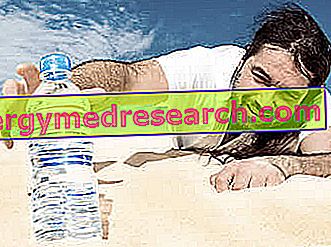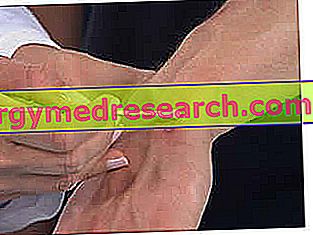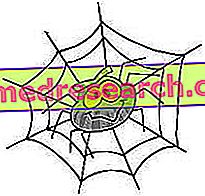Dehydration means a significant loss of body water.
Water makes up about 55% of the weight of an adult organism.
An "apparently" insignificant reduction, estimated as a percentage of the total body mass, can compromise the subject's psycho-physical performance.

The loss of body fluids occurs mainly with:
- Sweating.
- Urine.
- Stool.
- Lung ventilation (air humidification in the breasts and turbinates).
The dehydration mainly affects:
- Patients with gastrointestinal infectious diseases (in the presence of vomiting and diarrhea), renal, endocrine and eating disorders (anorexia), etc.
- Children: they have an underdeveloped thirst stimulus.
- Elderly: they have an inefficient thirst stimulus; moreover, over time the body tends to retain less water.
- Sports: they have an almost exponential sweating compared to a sedentary one, especially in the summer season.
- Those who work in extremely strenuous or hot environments: kitchen workers, farm workers, etc.
- Those who follow extreme diets such as ketogens or those who take diuretics.
What to do
- In case of vomiting and diarrhea (typical of gastro-enteritis but not only), treat the causative agent.
- In the case of hormonal or renal diseases, the risk of dehydration will be reduced proportionally to the cure of the disease.
- Induce children and the elderly to drink even when they do not feel thirsty.
- Follow a balanced diet (see below).
- Hydrate yourself properly during sport.
- In the summer, play sports in the coolest orchards.
- Use clothing that is suitable for the condition, preferably a technical one.
- If possible, reduce exposure to strong and hot drafts.
- At high altitudes, moisturize properly despite temperatures that are not too high, as the body must moisten the ventilation air more.
- Drink also during aquatic and underwater activities.
- Wanting to practice saunas and Turkish baths, calculate the times intelligently and starting progressively.
- Limit exposure to direct sunlight.
- Start drinking earlier, continue during and even after a very intense sweating.
- Prefer the isotonic solutions alternating with water.
- To understand if the body really suffers from dehydration, check for the following symptoms:
- Thirst.
- Body weight reduction.
- Muscle cramps.
- Weakness.
- Reduction of diuresis.
- Dark urine.
- Dryness of the lips, skin and mucous membranes (nose, oral cavity, eyes, etc.).
- In the most serious cases:
- Increased body temperature.
- Eye sagging.
- Increased heart rate.
- Blurring of the senses.
- No tears to cry.
- Coldness of the extremities.
NB . We remind you that a 2-3% loss is not difficult to obtain. If the scale shows a significant reduction in weight in a short or very short time, it is almost certainly dehydration.
- WARNING! In case of unconsciousness (for example during very intense athletic performances), before intervening, it is necessary to consult the doctor to avoid making the situation worse.
In fact, not everyone knows that some of the symptoms related to hypokalemia (potassium reduction) are very similar to those of dehydration (asthenia, mental confusion, hyposthenia and muscle cramps, paralysis). By forcibly hydrating an organism lacking potassium, the situation can be further aggravated.
- After obtaining the clinical certainty of dehydration it is essential to proceed with a rapid and effective rehydration. The best methods are:
- Drinking an easily absorbable solution.
- If the subject is unconscious or is particularly serious, the emergency department will apply an intravenous glucoserosaline infusion (phleboclysis).
- Once the acute phase is complete, it is necessary to provide for a progressive rehydration. The organism is not a "container" to be filled. Both water and nutrients move from one tissue to another through a complex system of membranes and exploiting concentration gradients, specific channels, etc. For this reason rehydration must be progressive, prolonged and respectful of some very specific nutritional principles (see below).
What NOT to do
- Prolong symptoms of vomiting and diarrhea.
- Neglecting polyuria induced by renal and hormonal diseases.
- Let children and the elderly drink from time to time.
- Take diuretics.
- Follow dehydrating diets like ketogenic and those poor in watery foods.
- Practicing sports without hydrating yourself and following an unbalanced diet.
- Practicing sports during the hottest hours of summer.
- Use plastic coveralls or other synthetic clothing to increase sweating (waistcoat, rubber shorts, etc.).
- Expose yourself to very strong and hot air currents. By quickly wiping sweat, they can hide the degree of sweating.
- Underestimate the altitude.
- Underestimate the urination and sweating during aquatic and especially underwater activities.
- Expose yourself to extended saunas and steam baths.
- Expose yourself to sunlight for many hours (for example by falling asleep in the sun).
- Neglecting the presence of symptoms that may indicate a state of dehydration.
- Ignore the possibility that it is hypokalemia and not dehydration.
- Drinking hypotonic or hypertonic solutions: they are poorly absorbed and can trigger diarrhea, worsening the situation.
What to eat
To prevent dehydration or rehydrate the body it is necessary to drink and eat correctly:
- If the level of global physical activity does not include sport and sweating is normal, it is sufficient to introduce 1ml of water every calorie taken with the diet (for a 200kcal diet we recommend 2 liters of water). This estimate should also include the water contained in foods (about 0.8-1.5 liters / day) but, to minimize the risk of dehydration, it is advisable to apply this number only to beverages.
- If sweating is intense due to motor activity, it is advisable to estimate the quantity of liquids to be reintroduced by carrying out double weighing before and after training. The difference between the two values corresponds to the actual loss of liquids to be reintroduced. This is a very useful parameter in planning future training sessions.
- If the loss of fluids is considerable, it becomes necessary to split the drinks before, during and after the session. Drinking all at once can be very annoying.
- In the case of sports, diarrhea and intense sweating, prefer isotonic or mildly hypotonic liquids. These are better absorbed, participate in restoring the salt balance and provide energy. They contain semi-complex carbohydrates between 5-10% (better at 6-8%) and minerals (especially potassium and sodium). The optimal temperature is 8-13 ° C.
- During daily meals, choose foods that contain a fair amount of water:
- Fresh fruits and vegetables: the VI and VII fundamental group of foods is the one that participates most in the supply of water and potassium in the diet. Portions can be 3-6 per day and range from 50 to 300g.
- Minestrones: they are based on cooked vegetables, but they have the advantage of containing even more water. Moreover, unlike many other recipes with cooked vegetables, the minestrone recipe does not suffer any mineral loss.
- Juices, centrifuges and smoothies: to be consumed in secondary meals.
- Tea and herbal teas.
- Milk and yogurt: they have a very high water content; the portions are 1-3 per day (250ml for milk and 125g for yogurt).
- Fresh meat, fish and eggs: using appropriate cooking methods, these foods also support hydration. It is advisable to prepare them with the following methods: raw food, boiling in water, vacuum, steam, pressure and vasocottura. Not to be excluded even in foil, baked crust and stir-fry.
- First course soups based on cereals and legumes: the eventual soaking and cooking in water of these starchy seeds (or derivatives) increases their hydration by 100-200%. The portions are 1-2 per day and range from 30g to 80g of food and 250-500ml of broth or water. However, preferring recipes in broth the amount of liquid also increases by 4 times.
- Follow a balanced diet with the right percentage of macronutrients (including carbohydrates).
What NOT to Eat
The exclusive consumption of low-hydrated foods and some diuretic products may predispose to dehydration:
- Preserved, cooked or dehydrated fruits and vegetables: jams, cooked and squeezed herbs, concentrates, candied or dried fruit, etc.
- Aged cheeses: unlike fresh cheeses, they have a low concentration of water.
- Preserved, cooked or dehydrated meat and fish: overcooked and concentrated meat sauces, grilled for a long time, cured meats and cured meats etc.
- Breadsticks, crackers, biscuits and croutons instead of fresh bread and first courses.
Some molecules can be diuretic and promote the excretion of water; among these we remember above all:
- Ethyl alcohol: it is strongly diuretic.
- Stimulants: the most common is caffeine. They are mainly found in coffee, in certain energy drinks and in thermogenic food supplements.
- Ketone bodies: they are produced by the body in the absence of carbohydrates. They are typical of ketogenic diets, ie unbalanced nutritional regimes aimed at weight loss. Having a very strong osmotic power, when they are filtered by the kidneys they also take away a lot of water contained in the blood plasma.
- Medicinal plants with diuretic action: dandelion, goldenrod, horsetail, birch, juniper, nettle, bermuda grass and asparagus.
Natural Cures and Remedies
Natural remedies for dehydration are nothing but the foods themselves. Those are particularly effective:
- Rich in water.
- Rich in potassium, but also in sodium.
- With a fair percentage of carbohydrates.
- Poor fruit-oligosaccharides and other osmotic carbohydrates not reabsorbable at the tubular level of the kidneys.
- Poor caffeine and other stimulants.
- Alcohol free.
- With natural and not excessive concentrations of potassium, vitamin C and vitamin B6.
Pharmacological care
- Rehydrating therapy: it is based on formulas rich in electrolytes to be dissolved in water; often simple and semi-complex carbohydrates are added. It can be performed for:
- Oral.
- Intravenous (drip).
- In case of vomiting, antiemetic drugs. A classic example is antimuscarinics such as scopolamine (for example Addofix)
- In case of diarrhea: antispasmodics, anticholinergics, intestinal absorbents and specific antibiotics or antiparasitics.
- In case of eating disorders: anxiolytics, antidepressants etc.
- In the case of diabetes insipidus and other endocrine diseases: synthetic hormones.
Prevention
The prevention of dehydration can only be done when the dehydrating agent is known:
- Treat any diseases that can cause dehydration.
- Carefully evaluate the variables of the case (high altitude, underwater activities, hot wind, direct sun, etc.).
- Drink and eat properly, especially in the presence of heat and intense sporting activity.
- Drink even when you are not thirsty; without exaggerating, small sips are sufficient.
- Dress specifically and choose times with acceptable temperatures.
Medical Treatments
There are no specific medical treatments to treat or prevent dehydration.
The only exception is surgical interventions aimed at treating higher pathologies.



